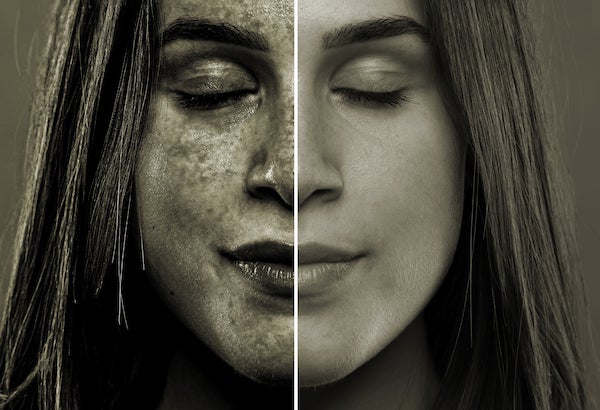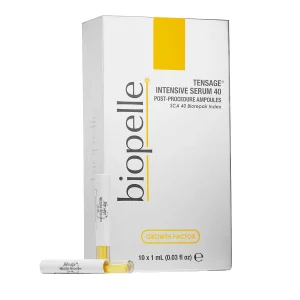Sunshine is a good thing for our health, moods and sleep schedules. Our bodies absorb and use sunlight to make vitamin D, which plays an important role in preventing heart disease, osteoporosis and other diseases. Vitamin D also supports healthy immune system function and good mental health.
But too much of a good thing can be harmful.
When our skin is exposed to excessive ultraviolet (UV) rays from the sun, it can lead to premature aging, wrinkles and even skin cancer. Whatever your age and whatever condition your skin is in, there are steps you can take to halt and maybe even reverse your skin’s UV damage. Keep reading to learn more about the causes and consequences of photo-damaged skin and how you can prevent it.
What is Photodamage?
Photodamage is a term that describes one of the possible effects the sun’s UV rays can have on our skin. While our bodies are often largely covered by clothing during everyday exposure to the sun, our faces are rarely shielded from UV rays in the same way. That’s why our facial skin is often one of the first places that evidence of UV damage becomes apparent.
Photodamage is cumulative and is made worse each time we expose our unprotected skin to the sun. Every sunburn adds significant damage to our skin’s already injured dermal layer. Signs of UV damage to the skin include:
- Wrinkles, especially around the eyes and mouth and on the forehead
- Reduced elasticity and loss of skin tone
- Hyperpigmentation, such as sun spots and freckles
- Roughening skin and red blotches
- Broken capillaries around the nose and chest—sometimes called spider veins
How Can I Prevent Photodamage?
It’s hard to imagine avoiding photodamage completely. Being out in the sun is one of life’s many pleasures. Whether you’ve been using SPF perfectly for years or are just turning your attention to better skin health now, you can slow the photo-aging process by making good choices from here on out. Following these basic steps can prevent more photodamage and help your skin repair itself better:
- Apply broad-spectrum sunscreen when exposed to sunlight. Reapply it at least every two hours, but more frequently if you’re swimming or sweating through a workout. Choose a non-comedogenic product with at least SPF 30 protection.
- Clothing and wide-brimmed hats can provide coverage and shade for your skin. When outdoors, wear clothing that covers sun-prone parts of your body, like your shoulders and back.
- Avoid going outdoors midday, when the sun is at its peak. Go for your daily walk or bike ride in the morning or evening, when the sun is lower in the sky.
- Be conscious of lifestyle choices that could impact photo-aging. For example, don’t lay in the sun or use tanning beds; instead, try a self-tanning product to achieve that bronzed look. Sit in shaded outdoor areas whenever possible. Or, enjoy a beautiful, sunny view from inside.
- Stay hydrated and eat a balanced diet rich in antioxidants. This gives your skin the nutrients it needs to repair itself.
Can I Reverse Sun Damage to My Skin?

Tensage Intensive Serum 40
If you’re seeing early signs of photo-aging or are younger and looking to slow damage early on, you may be able to help reduce the appearance of photo-damage. Topical treatments that contain retinoids, retinols, vitamin C, D, and E, and alpha hydroxy acid may provide some symptom reversal. And remember: It’s never too late to start preventing further damage and work toward improving your skin’s health.
If you have moderate sun damage or if topical products haven’t worked, more intensive procedures may hold the answer. Chemical peels, laser resurfacing, cryotherapy, or microdermabrasion may help reduce signs of photodamage and reveal a smoother, more youthful-looking skin surface. Dermal filler products like Botox, Voluma, or Juvederm may provide a solution for the appearance of fine lines and wrinkles.
Hyperpigmentation and Anti-Aging Products to Help Reverse Signs of Photodamage
If you are looking for products to reverse the signs of photodamage, you’ll want to focus on high-quality skincare designed for hyperpigmentation—the most visible sign of photodamage. Biopelle offers hyperpigmentation and anti-aging products that incorporate proven ingredients to help promote more youthful-looking skin.
Award-winning Tensage Intensive Serum 40 is clinically proven to help improve the appearance of fine lines, wrinkles and uneven skin texture and tone. This formula contains natural growth factors, antioxidants, and hyaluronic acid to help boost elasticity and improve skin tone and texture. Visible improvements in redness, smoothness and luminosity can be seen in as few as 24 hours.
To more effectively treat signs of hyperpigmentation, XCP Brightening Serum combines L-Ascorbic acid with phytic acid, green tea extract and grape seed extract to brighten skin tone and defend against damaging free radicals.
Browse all of Biopelle’s hyperpigmentation products to find the right combination of skin care products that perfectly addresses your concerns.

